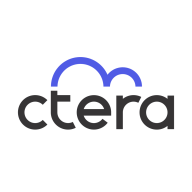

CTERA Enterprise File Services Platform and OpenText Content Management compete in the file and content management category. CTERA has an upper hand in pricing and customer support, while OpenText excels in features and integration capabilities.
Features: CTERA offers robust scalability and resilience with flexible implementation. It supports hybrid cloud environments and provides an adaptive backup solution for remote work scenarios. OpenText provides extensive integration with business applications, comprehensive document management, and metadata tagging, along with robust search functionalities.
Room for Improvement: CTERA could improve monitoring capabilities, streamline version control, and enhance user experience and logging. OpenText users want improvements in analytics, machine learning, user support, and interface usability. The complexity in workflow integrations and high costs also need addressing.
Ease of Deployment and Customer Service: CTERA allows deployment across on-premises and hybrid cloud environments with high customer service ratings for accessibility and problem resolution. OpenText also offers diverse deployment options but has mixed reviews regarding customer service experience.
Pricing and ROI: CTERA is praised for a competitive pricing model and flexible software licensing, allowing significant savings. OpenText is perceived as more expensive with complex licensing structures, though its feature set offers valued integration and functionality to some users.
Adding SSD storage to Windows file servers is expensive, and we no longer need to back up those devices.
I am positive that CTERA has helped reduce the total cost of ownership by eliminating the need for manual storage management and reducing storage service processes.
ROI may be very short if you use OpenText Content Management system effectively.
They swiftly address concerns and take ownership of the call, providing a very satisfactory support experience.
High-priority issues are handled promptly.
I would rate their support a ten out of ten.
The staff lacks adequate knowledge.
Currently, they are improving support and transitioning to a new solution, which is better than what they implemented in the past three to four years.
If we need to upgrade CPU and memory, we should be able to do that without a license upgrade.
CTERA is a very scalable product, allowing us to grow.
It offers good scalability options, including vertical and outward scalability.
There is not enough documentation about scaling, which makes it difficult to enhance or modify environments without significant effort.
It has been pretty stable since then.
We had things deployed for years, and we were suddenly getting cloud sync issues that were crashing our sites.
It is very stable and reliable.
The product is quite stable if it is well-managed.
AI and automation features could enhance the platform, such as AI-powered search, predictive storage analytics, and intelligent alerts for proactive monitoring.
The main problem is that if two people are working on the same file, for example, one in the U.S. and one in Israel, they can overwrite each other’s work without any notification.
It would help to have a global single-pane-of-glass view of all my CTERA devices.
The expectation from the customer versus the product explanation needs alignment.
Another important aspect is the improvement of the artificial intelligence already embedded in OpenText Content Management solution.
Unlike other solutions that require hardware purchases, CTERA offers software licensing with flexibility across multiple infrastructure providers.
CTERA’s pricing should be more proportional and accessible so that cost is not the factor preventing customers from purchasing.
CTERA's pricing seems to be on par with some of the other players, such as Nasuni and Azure.
If you compare it to an archiving solution and you are using content management only for archiving, the cost of the license may seem too high, as you are paying for a license that not only includes archiving but also controls the full life cycle of information, connects with SAP and Salesforce, features a native connection with Office 365, and supports parallel editing.
The cost is a significant factor that may deter medium-sized businesses from using OpenText extended ECM.
As soon as something is written to the device, CTERA copies it to the cloud, where it's versioned with snapshots so we can recover it.
A vital advantage of this platform is its instantaneous recovery capability, allowing seamless access to a secondary gateway if the primary one fails.
It is a three-in-one solution for us. It is a file-sharing platform, an archiving solution, and also a backup solution.
The seamless integration between SAP and OpenText offers a 360-degree view of documents, facilitating a full-text search capability.
OpenText Content Management has a feature that is unique in the market, which is the deep integration with leading applications, allowing reflection of the connections between different processes and objects in applications such as SAP, SuccessFactors, or Salesforce, visible inside the document management application.
| Product | Market Share (%) |
|---|---|
| CTERA Enterprise File Services Platform | 1.4% |
| OpenText Content Management | 2.0% |
| Other | 96.6% |


| Company Size | Count |
|---|---|
| Small Business | 2 |
| Midsize Enterprise | 2 |
| Large Enterprise | 6 |
| Company Size | Count |
|---|---|
| Small Business | 13 |
| Midsize Enterprise | 4 |
| Large Enterprise | 11 |
The CTERA Enterprise File Services Platform provides a cloud-native global file system over public and private object storage, revolutionizing the world of hybrid cloud data solutions. Enhanced by a rich data services ecosystem, CTERA enables enterprises to gain full control of their data for optimal edge performance, data insight, and governance. The platform focuses on security, providing features like data encryption, access controls, and ransomware protection. Centralized management tools enable efficient data control and monitoring. The platform is being used to replace legacy NAS and file servers, especially at remote locations, and simplify backup and disaster recovery of file data while providing the flexibility of multi-cloud deployments with infinite scalability. CTERA is at the core of hybrid cloud transformations of some of the world’s largest banks, healthcare organizations, global media groups, and government agencies, in deployments that scale to tens of petabytes.
OpenText Content Management offers seamless document storage and advanced search features. Ideal for organizations needing integration with SAP and other applications, it enhances workflows while ensuring security and compliance across multiple platforms.
OpenText Content Management stands out with its advanced integration capabilities, allowing seamless connectivity with SAP and other applications. Its enhanced security and permission systems safeguard information, vital for industries like banking, utilities, and oil & gas. Metadata categorization and customizable workflows aid in managing complex document lifecycles. Although improvements in visibility and integration with external tools are needed, the platform provides powerful collaboration tools, enhancing productivity. Users leverage document retention and WebReports features to ensure compliance. Challenges with support, performance during peak times, and architecture complexity are noted. Automation features and analytics require enhancement, alongside more user-friendly SmartUI and record management functionalities.
What key features define OpenText Content Management?OpenText Content Management is widely utilized in sectors such as banking, utilities, and oil & gas. It is implemented to manage software development projects, engineering documents, and workflow automation. Organizations leverage OpenText Extended ECM for document lifecycle management, post-project archiving, and records retention. Integration with platforms like ServiceNow allows efficient handling of document management across global operations, supporting information governance, tax return compilation, and capital projects.
We monitor all Content Collaboration Platforms reviews to prevent fraudulent reviews and keep review quality high. We do not post reviews by company employees or direct competitors. We validate each review for authenticity via cross-reference with LinkedIn, and personal follow-up with the reviewer when necessary.